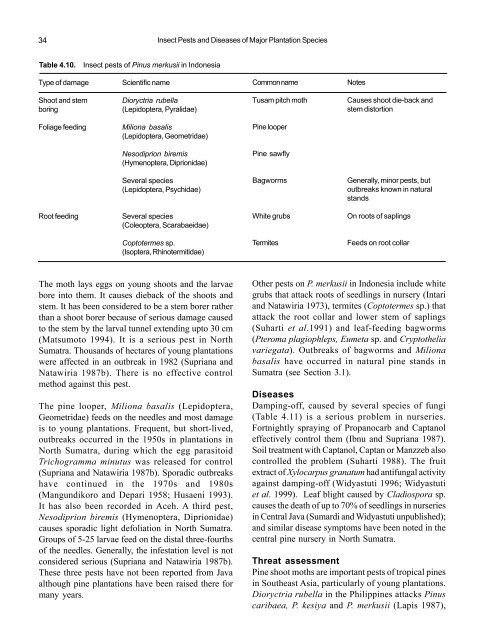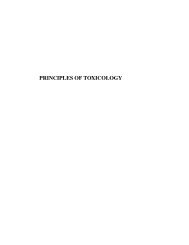Insect-pests - Biology East Borneo
Insect-pests - Biology East Borneo
Insect-pests - Biology East Borneo
Create successful ePaper yourself
Turn your PDF publications into a flip-book with our unique Google optimized e-Paper software.
34 <strong>Insect</strong> Pests and Diseases of Major Plantation Species<br />
Table 4.10. <strong>Insect</strong> <strong>pests</strong> of Pinus merkusii in Indonesia<br />
Type of damage<br />
Scientific name<br />
Common name<br />
Notes<br />
Shoot and stem<br />
boring<br />
Dioryctria rubella<br />
(Lepidoptera, Pyralidae)<br />
Tusam pitch moth<br />
Causes shoot die-back and<br />
stem distortion<br />
Foliage feeding<br />
Miliona basalis<br />
(Lepidoptera, Geometridae)<br />
Pine looper<br />
Nesodiprion biremis<br />
(Hymenoptera, Diprionidae)<br />
Pine sawfly<br />
Several species<br />
(Lepidoptera, Psychidae)<br />
Bagworms<br />
Generally, minor <strong>pests</strong>, but<br />
outbreaks known in natural<br />
stands<br />
Root feeding<br />
Several species<br />
(Coleoptera, Scarabaeidae)<br />
White grubs<br />
On roots of saplings<br />
Coptotermes sp.<br />
(Isoptera, Rhinotermitidae)<br />
Termites<br />
Feeds on root collar<br />
The moth lays eggs on young shoots and the larvae<br />
bore into them. It causes dieback of the shoots and<br />
stem. It has been considered to be a stem borer rather<br />
than a shoot borer because of serious damage caused<br />
to the stem by the larval tunnel extending upto 30 cm<br />
(Matsumoto 1994). It is a serious pest in North<br />
Sumatra. Thousands of hectares of young plantations<br />
were affected in an outbreak in 1982 (Supriana and<br />
Natawiria 1987b). There is no effective control<br />
method against this pest.<br />
The pine looper, Miliona basalis (Lepidoptera,<br />
Geometridae) feeds on the needles and most damage<br />
is to young plantations. Frequent, but short-lived,<br />
outbreaks occurred in the 1950s in plantations in<br />
North Sumatra, during which the egg parasitoid<br />
Trichogramma minutus was released for control<br />
(Supriana and Natawiria 1987b). Sporadic outbreaks<br />
have continued in the 1970s and 1980s<br />
(Mangundikoro and Depari 1958; Husaeni 1993).<br />
It has also been recorded in Aceh. A third pest,<br />
Nesodiprion biremis (Hymenoptera, Diprionidae)<br />
causes sporadic light defoliation in North Sumatra.<br />
Groups of 5-25 larvae feed on the distal three-fourths<br />
of the needles. Generally, the infestation level is not<br />
considered serious (Supriana and Natawiria 1987b).<br />
These three <strong>pests</strong> have not been reported from Java<br />
although pine plantations have been raised there for<br />
many years.<br />
Other <strong>pests</strong> on P. merkusii in Indonesia include white<br />
grubs that attack roots of seedlings in nursery (Intari<br />
and Natawiria 1973), termites (Coptotermes sp.) that<br />
attack the root collar and lower stem of saplings<br />
(Suharti et al.1991) and leaf-feeding bagworms<br />
(Pteroma plagiophleps, Eumeta sp. and Cryptothelia<br />
variegata). Outbreaks of bagworms and Miliona<br />
basalis have occurred in natural pine stands in<br />
Sumatra (see Section 3.1).<br />
Diseases<br />
Damping-off, caused by several species of fungi<br />
(Table 4.11) is a serious problem in nurseries.<br />
Fortnightly spraying of Propanocarb and Captanol<br />
effectively control them (Ibnu and Supriana 1987).<br />
Soil treatment with Captanol, Captan or Manzzeb also<br />
controlled the problem (Suharti 1988). The fruit<br />
extract of Xylocarpus granatum had antifungal activity<br />
against damping-off (Widyastuti 1996; Widyastuti<br />
et al. 1999). Leaf blight caused by Cladiospora sp.<br />
causes the death of up to 70% of seedlings in nurseries<br />
in Central Java (Sumardi and Widyastuti unpublished);<br />
and similar disease symptoms have been noted in the<br />
central pine nursery in North Sumatra.<br />
Threat assessment<br />
Pine shoot moths are important <strong>pests</strong> of tropical pines<br />
in Southeast Asia, particularly of young plantations.<br />
Dioryctria rubella in the Philippines attacks Pinus<br />
caribaea, P. kesiya and P. merkusii (Lapis 1987),
















